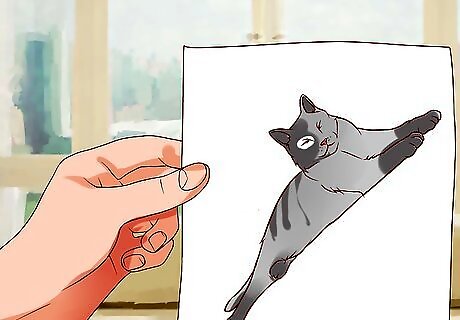
views
Desensitizing with Pictures and Videos

Search the internet for images of cats. Be sure to save each picture that you find to your computer. Try to find a variety of cats that vary in size, color, hair type, etc. Also, make sure that you get some pictures that are close-up shots as well as photos that show cats engaging in their everyday routine such as walking, eating, lying down, and interacting with people. You don't have to limit your picture search to the internet. You can also find similar pictures in magazines and pamphlets.

Select one of the pictures and print it out, preferably in color. Look at the picture and determine where you are on the anxiety scale. You do this by deciding how much anxiety you experience on a scale of 1-10. One represents virtually no anxiety while 10 reflects extreme anxiety.

Look at the picture for several minutes each day. As you do this, try to keep yourself calm. Also, do your best to refrain from looking away. If you do find yourself looking away, be sure to refocus on the picture as soon as you notice. Continue this each day until you experience very little anxiety when you look at the picture. Determine in advance how long you will look at the picture each day. 10-15 minutes seems to be a reasonable amount of time to participate in this daily activity. If you find yourself getting anxious, try deep breathing to regain your composure. Sit in a chair that can support your back. Breathe in so that the air moves from your belly to your chest. Count to four as you slowly breathe in. Then breathe out so that you feel the air moving back down from your chest and out of your body. Count to seven as you release the air. Repeat as needed. Try using this relaxation technique as you look at the picture of the cat. After a few days of doing this, the anxiety that you experience should lessen. Be sure to always note where you are on the anxiety scale. Remember, your goal should be to get to a one or two on the scale.

Print out the remaining cat pictures that you have saved on your computer. Use these pictures to create a collage by gluing them all onto a poster board. When you are no longer experiencing anxiety from looking at the picture of a single cat, now it’s time to move on to looking at multiple cat pictures. Taking this approach allows you to slowly build your confidence. Be sure to spend several minutes each day intentionally looking at the collage. Continue to do this until the pictures no longer cause you anxiety. You are slowly increasing your exposure by starting with a picture of one cat and moving to pictures of multiple cats. The goal is to eventually desensitize yourself from cats altogether. However, if you start with multiple cats, it may become too overwhelming, causing you to quit before it works. Therefore, it’s important to start with something that you can handle. You may want to hang the collage in an area where you will frequently see it. This can help quicken the desensitization process. However, continue to set aside 10-15 minutes specifically for this activity. Remember, the goal is to reach a one or two on the anxiety scale when looking at the collage.

Watch videos of cats. Search for short videos of cats on YouTube that are pleasant to watch and repeatedly view them for a few days. Initially this may be anxiety provoking but you should continue to watch the videos until they no longer cause you anxiety. Watching videos is a great way to prepare you for the transition from looking at pictures of cats to making actual physical contact. It may be a good idea to have a friend preview the Youtube videos before you watch them. This way you can avoid the occasional video that shows an unfriendly cat which could worsen the phobia. Continue to monitor your anxiety scale. When you reach one or two on the scale then you can move to making physical contact.
Making Physical Contact

Call a friend who owns a cat and tell him about your fear. Explain to your friend that you would like to learn to be more comfortable around cats and that you need his help. Ask him if you could come over daily for the next few weeks so that you can get used to being around cats. It may be difficult to get to your friend’s home every day, however it is important to make contact with cats as often as possible. Pick a schedule and stick with it. When you gradually expose yourself to what you are afraid of, the body adjusts and eventually stops releasing stress hormones. Therefore, the more time that you spend around cats, the quicker you’ll lose the fear of cats. Make sure to select a friend who has a friendly cat. Your friend will probably already know whether his pet is a good fit for this activity or not. However it's probably a good idea to ask him if the cat is friendly before starting the visits.

Watch the cat from a distance. The first time that you make contact with a cat, ensure that it is a comfortable distance away. Ask your friend to keep the cat in another room where you can see it but the animal is unable to make direct contact with you. You could also ask your friend to hold the cat as he stands across the room from you. Stay at your friend’s house for about 10-15 minutes and then give yourself permission to leave. Continue to do this until you no longer feel anxious.

Sit near the cat. Using an animal carrier is a great way to start start. Ask your friend to put the cat in an animal carrier and allow it to be placed close to you. Two to three feet away would be a good proximity. Remain in that close proximity to the cat for 10-15 minutes and then give yourself permission to leave. Continue this until you no longer feel anxious.

Ask your friend to sit next to you while holding the cat on his lap. This allows you to be near an unrestrained cat, but because your friend is holding the animal it is more controlled. Sit there for 10-15 minutes and then give yourself permission to leave. Continue to do this until you no longer experience any anxiety. Remember, you do not have to touch the animal at this point. The idea is to be near the animal so that you can get used to being close to the cat outside of the carrier. Although this will likely cause some discomfort, if you begin to feel overwhelmed at any point, it is okay for you to discontinue. Always try to end with success. If you feel overwhelmed and decide to discontinue, try asking your friend to put the cat back in the carrier or ask him if he could move away a little. Try to wait to leave until you are no longer feeling overwhelmed. This way you can lessen the anxiety without reinforcing the fear.

Pet the cat. Allow yourself to physically touch the animal. Start with a few seconds of touching and gradually work your way up. Be sure to only touch the cat in areas that doesn’t make him uncomfortable. Dr. Marty Becker suggests that there are a few places that cats love to be pet and one place that you should avoid: Cats enjoy being rubbed at the base of the chin where the jawbone and the skull connect. The base of the ears and cheeks behind the whiskers also seem to be pleasure zones for most cats. Cats also seem to enjoy being gently stroked down their backs with slight pressure being applied when you get to the tailbone. Avoid petting cats on their belly. Although dogs like this, cats feel vulnerable and may not respond well to this gesture.

Hold the cat on your lap. After you are comfortable petting the cat, allow the cat to climb onto your lap. Let it remain on your lap for a few seconds or minutes (whatever you are comfortable with) and then ask your friend to remove it. When you are able to successfully hold the cat with no anxiety, then you have probably gotten over your fear of cats.

Go near cats regularly. This is very important because fears can come back if you don’t keep working at it. Therefore, it is important for you to continue to expose yourself to cats on a regular basis so that your fear does not creep back in. Try to visit homes with cats on a regular so that you continue to feel comfortable around them. Going to a pet store when you don’t have access to cats otherwise is a good alternative. This might be especially good if your friends who care for cats are out of town.
Restructuring Your Thoughts

Recognize that your cat phobia is likely being exacerbated by unhelpful thoughts. Most people who are afraid of cats are already aware that cats are pretty harmless. However, they have a fear response that is initiated in the brain that they can’t currently control. Phobias are often learned behavior. A person may have one bad experience with a cat, he may have subconsciously begun to associate cats with negative things such as illness, or he may have “learned” to be afraid of cats by watching his parents’ fearful behavior around them when he was a child. Multiple brain regions are involved in phobias. Therefore, it will take you some time to retrain your brain to think and respond differently to cats.

Make a list of all the negative and unhelpful thoughts that you experience when you are near cats. When you are able to identify those unhelpful thoughts, then you can begin to evaluate them. You will probably see that most of these thoughts fall into one (or more) of these three cognitive distortions: Fortune telling is when a person assumes they know what the outcome of a situation is going to be without any true evidence to support it. For example, you may think “This cat is going to scratch me” even though you’ve never had any interaction with that cat before. Overgeneralizing is when a person takes one specific event and generalizes it to all events. For example, you may think “My friend’s cat scratched me two years ago therefore all cats are vicious.” Catastrophizing is when you predict that a negative outcome is going to occur and believe that when it does, it will result in a catastrophe. Catastrophizing is when you assume a situation is going to be the absolute worst case scenario. For example, you may think “If the cat scratches me, I will get an infection and die.”

Replace the negative thoughts with more helpful thoughts. You can do this by creating alternative statements to counteract the negative thought. When doing this, you are essentially retraining your subconscious to release the unhelpful cognitive distortions and replace them with more positive beliefs. Focus on replacing the negative thought with a positive statement that helps you emphasize neutral or more positive outcomes. For example, you could replace the thought “This cat is going to scratch me” with a statement like “Many people interact with cats every day and do not get scratched.” You can even begin by using statements that are less negative then your original thought. For example, you could replace the thought “If the cat scratches me, I will get an infection and die” with the less negative statement, “The worst thing that could happen is that the cat scratches me and runs away. I’ve been scratched before and it’s not so bad. I won’t likely get an infection.” Eventually you can replace the less negative thought with something even more positive. Try to do this whenever a negative thought pops up. Eventually you’ll begin to think more positively about cats.














Comments
0 comment